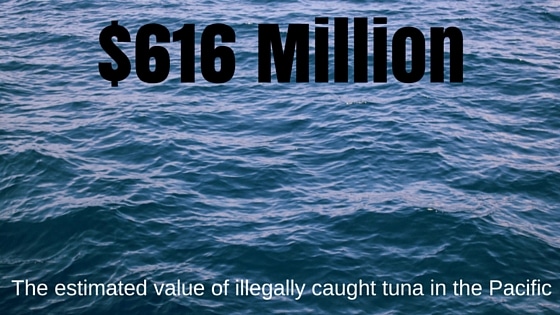Illegal Fishing by Some Countries is Devastating our Oceans and Economies

We have previously reported that tuna populations are not nearly as robust as they were 30 years ago, as the true cost of illegal fishing is starting to become more apparent. While some fishing methods have become more sustainable, there is a dark specter which continues to drive tuna populations down. That specter comes in the form of unregulated, illegal fishing.
It is difficult to get a clear picture of just how devastating IUU fishing is to the environment and seafood populations, but a recent study carried out by the Pacific Islands Forum Fisheries Agency has found that illegal fishing has been netting huge profits for criminals in the Pacific. How huge? US $616 million a year, and that is only including IUU fishing in the Pacific tuna sector. That is over 300,000 tonnes of tuna.
How do criminals manage to pass of their catches as legitimate? Globally, there has been a push towards highly regulated fishing. This has made seafood more traceable, with sustainable certification offered by third parties for fisheries most committed to sustainability. Many countries have increased restrictions on imports of seafood, requiring them to meet sustainability standards. Programs such as the EU Catch Certification Program have made it more difficult for criminals to sell their illicit catch, and that has caused a trend towards misreporting and under-reporting catches.
Poaching Fish Our Waters And Passing The Cost To Consumers
Currently, only 4% of IUU fishing is caused by poachers The rest is through misreporting and under-reporting catches. The long line fishing industry saw the bulk of the IUU fishing, with only 37% of IUU fishing originating from the purse seine sector. This correlates with the fact that only 5% of long line fishing vessels have Observer coverage compared to 100% Observer coverage in the purse seine sector.
Tuna is a boon to local economies, some which utterly rely on it. The Honourable Elisala Pita, Minister for Natural Resources and Fisheries explained that her country of Tuvula relies on revenue from tuna to the point where it represents 45% of the government budget.
While the numbers that I previously quoted may seem devastating, they actually show that surveillance programs are working. Previous estimates had the IUU tuna catch valued at US $750 million to US $1 billion annually, and this number has been brought down not only by more effective catch regulations, but also monitoring, control and surveillance (MCS). There is currently more data and information sharing between countries, Africa being one where work to prevent illegal fishing is ongoing. These include many programs, including the satellite based Vessel Monitoring System and the observer program which has cut down IUU fishing in the purse seine sector of tuna substantially.
It is not clear where illegally caught tuna is ending up. But with tuna as the base ingredient to the most popular sushi dishes worldwide, the massive demand for the fish is always going to influence IUU fishing.
The fight against IUU fishing is a global one. It is important to have all countries working together to increase regulation, surveillance, and share data between governmental agencies. The cost is dear not only to at risk species but also the local economies of coastal countries which depend utterly on the sustainability of fishing practices and in the past have less power in combating IUU fishing.
I have always been fascinated by the creation and culture of different foods, particularly sushi and sashimi in the modern era of Japanese cuisine. I am a classically trained chef and sushi connoisseur, also having operated a food service company and enjoy investigating and experimenting with food around the world.